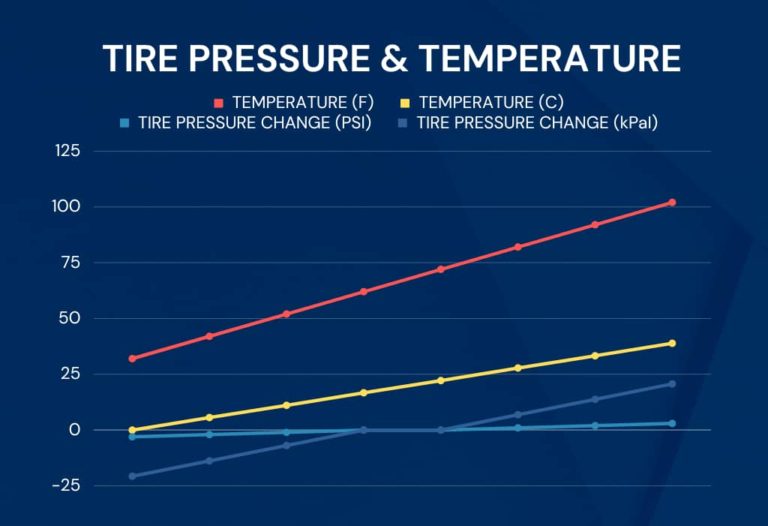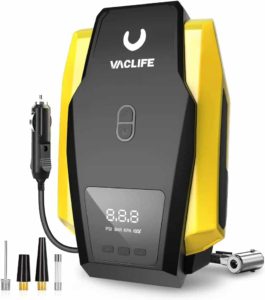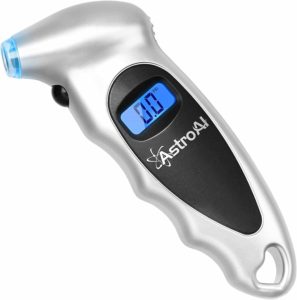Steps to Reset Hyundai Kona Tire Light
Step 1: Check and Adjust Hyundai Kona Tire Pressure
The Hyundai Kona does not have a button to reset the tire pressure. To turn off the tire light, you need to adjust your tire pressure to the exact pressure Hyundai recommends. Find the recommended pressure on the sticker on the driver side door pillar, in the chart below, or by using your steering wheel button to scroll over to your tire pressures display. Be sure to only adjust your tire pressure when the tires are cold. This means before driving or after the Kona has been parked for a few hours.
2023 Hyundai Kona Tire Pressure
Match your tire size to the chart below:
Tire Size | FRONT PSI | REAR PSI |
205/60R16 | 33 | 33 |
215/55R17 | 33 | 33 |
235/45R18 | 33 | 33 |
SPARE TIRE | 60 | 60 |
Step 2: Drive Your Kona
After filling your tires to the recommended cold pressure, take your Kona for a drive at speeds over 20 mph. You may see a “drive to display” message, but keep driving and the tire pressure light should turn off. If it doesn’t, keep driving a bit longer.
Re-check the Tire Pressure
If the tire pressure light is still on after doing steps 1 and 2, check your tire pressure again to make sure it’s correct. If it’s not, there may be a leak or puncture. If the light goes off after inflating but comes back on, there may be a leak. If the light blinks or flashes before staying on, it means there’s a problem with the tire pressure system, known as a TPMS malfunction.
Hyundai Kona TPMS Malfunction Indicator
The Hyundai Kona’s TPMS malfunction indicator uses the same yellow exclamation point tire warning light as the low pressure warning. There is a difference in how the light is used. If it flashes for about a minute before staying on, it means there’s a problem with the TPMS. The TPMS won’t work correctly until the problem is fixed. This means that if the light is flashing, the issue is with the TPMS, not the tire pressure itself. To find out which tire sensor is causing the problem, you’ll need a TPMS diagnostic tool like this Autel TPMS tool.
You Should Reset Your TPMS After:
Adjusting it to the recommended levels
Rotating or replacing tires
Wheel balances or alignments
Replacing or servicing a TPMS sensor
Installing a new wheel or changing tire size
Disconnecting, swapping, or jumping the vehicle’s battery
The TPMS malfunction indicator is on
Seasonal temperature changes that could affect tire pressure
How the Hyundai Kona TPMS Works
The TPMS on your Hyundai Kona makes sure your tire pressure is optimal, making your driving safer and more fuel efficient. Here’s how it works:
Direct TPMS: The Kona has pressure sensors inside each tire to continuously monitor tire pressure levels.
Wireless Transmission: Sensors wirelessly transmit tire pressure data to the onboard computer for real-time live monitoring.
Tire Pressure Display: You can access TPMS data through the vehicle’s display LCD to see the current tire pressure of each tire.
Low Pressure Warning: If any tire’s pressure falls below the recommended level, a warning light (yellow exclamation point) on the dashboard will come on.
Malfunction Indicator: The TPMS has a built-in malfunction indicator that uses the same warning light. If there’s a problem with the system, the light will flash for about a minute and then remain on until resolved.
Sensor Battery Life: TPMS sensors are battery-powered and usually last around 5-10 years. A low or failed battery will trigger the malfunction indicator.
Seasonal Changes: The TPMS can help identify seasonal temperature fluctuations and ensure tires remain at optimal pressure levels throughout the year.
What Causes the TPMS Light to Turn On?
The TPMS light on the Hyundai Kona can come on for several reasons, indicating potential problems that require attention. Here’s a complete list of causes:
Low Tire Pressure: One or more tires have lost pressure due to a slow leak, puncture, or natural pressure loss over time.
TPMS Malfunction: The warning light will flash for about 60 seconds and then stay lit if the TPMS is experiencing a problem, such as a faulty sensor, dead/dying sensor battery, or communication issues.
Seasonal Changes: Fluctuations in temperature will cause changes in tire pressure, leading to the TPMS light coming on when significant pressure changes occur. Read more about this below.
Tire Rotation or Replacement: The TPMS light might come on after a tire rotation or replacement if the system thinks the tires are in the wrong location (front to rear or rear to front) or if the tires weren’t filled to the correct pressures.
New Wheel or Tire Size Installation: The TPMS light could come on if the system hasn’t been recalibrated after installing new wheels or changing tire sizes. Remember, if you replace your wheels/rims, be sure to swap over the sensors from your old wheels to your new wheels.
Disconnected or Replaced Vehicle Battery: The TPMS light might be triggered if the vehicle’s battery has been disconnected or replaced.
Sensor Damage: Physical damage to a TPMS sensor, such as impact, corrosion, or improper installation, can cause the TPMS light to come on. A cracked rubber gasket in between the valve and sensor is also a common issue that can be fixed without replacing the whole sensor. You can use a TPMS repair kit like this.
How Weather Affects Tire Pressure
The graph shows how air temperature affects tire pressure. As it gets colder, tire pressure goes down, and as it gets warmer, it goes up. Tire pressure generally stays stable at around 62°F (16.7°C). For every 10-degree drop in air temperature, your tire pressure will go down by about 1 PSI.
What are the Benefits of TPMS in Hyundai Kona?
Safety: By constantly monitoring tire pressure, the TPMS reduces the risk of tire-related accidents caused by underinflation.
Fuel Efficiency: Properly inflated tires improve fuel efficiency, saving you money on gas in the long run.
Prolonged Tire Life: Tires with the right pressure levels experience more even tread wear and have a longer lifespan. The TPMS alerts you to pressure discrepancies, preventing premature tire tread wear.
Live Tire Monitoring: The TPMS provides real-time pressure data for each tire, enabling you to keep an eye on your tire health and make adjustments as needed.
Convenience: The TPMS eliminates the need for regular manual tire pressure checks, as it alerts you when there is a significant drop in pressure or a malfunction in the system.
Seasonal Adaptability: The TPMS helps you stay on top of tire pressure changes caused by temperature fluctuations during seasonal transitions, ensuring optimal tire performance throughout the year.
Everything in this article is applicable to all Hyundai Kona models and trims including the Kona N and Kona Electric.
Please note that this blog post contains Amazon affiliate links. This means that if you make a purchase through one of these links, we at TPMSRESET.com may earn a small commission at no extra cost to you. We only recommend products that we personally use and believe in. Thank you for supporting us.





